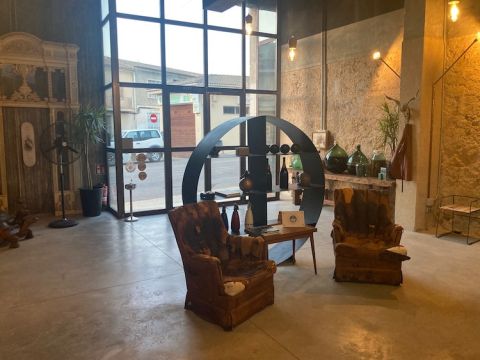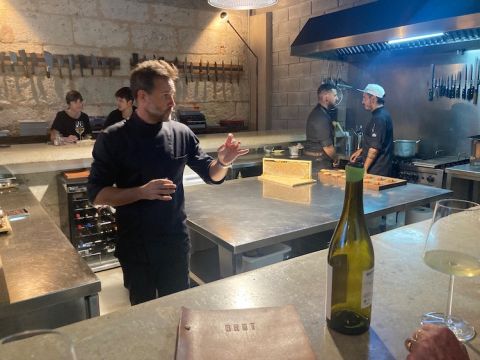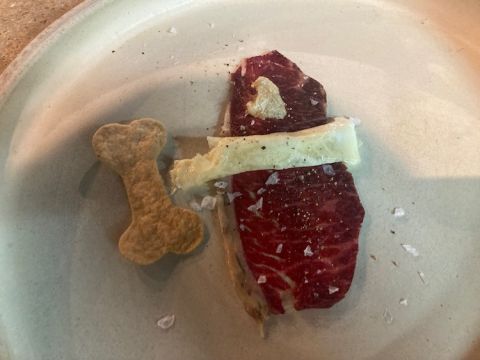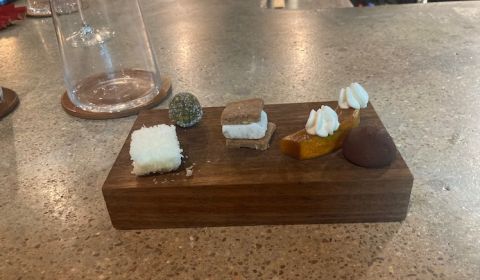A Brut of a restaurant
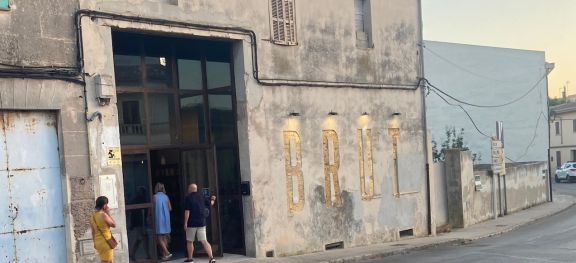
Nick discovers what could be an alternative el Bulli.
Our side trip to Mallorca at the beginning of this month began with me in a dubious mood. The friend we were staying with on our first night had proposed and booked, albeit with our agreement, a restaurant where all the customers had to arrive at the same time, 8.30 pm; where there was only a long and somewhat complicated menu of 12 different courses; and where the emphasis was on natural wines. I feared a protracted marathon with a 1 am finish.
Perhaps it was the football result that put me in a cheerful mood – the Lioness’s victory over Germany came over the car radio as we drove to the restaurant in the evening sunlight and parked right outside in the village of Llubí. Perhaps it was catching the name of the restaurant BRUT engraved in large, glistening gold letters on the outer stone walls of this former garage. But whatever the reason, we walked into the restaurant, smiling and happy.
The spaciousness of the interior may have played a part. The walls are conspicuously bare: to the left of the glass entrance hangs a solitary leather apron. Straight ahead are a couple of leather armchairs, well past their prime. To the right is a vitrine with jars of pickled fruit. And taking up much of the back of the space is a rather lovely concrete U-shaped bar that seats a maximum of 15 with an ultra-professional kitchen inside it.
There is more for both the eyes and the stomach. To the right of the bar is a window on to a collection of steel vats, Brut’s brewery, which produces a dozen beers (the dulce de leche IMP stout gives a clue to the owner’s place of birth). Hanging on the wall opposite is a collection of 15 quite dangerous-looking knives. And in between was the open, almost antiseptic-looking kitchen with three chefs walking round preparing for the show to start. (The extraordinary black and white photograph on the wall of the lavatory is another visual treat.)
Shortly after 8.35, Eduardo Martínez Gil (pictured above), henceforth referred to as Edu, silenced all 13 of us diners (our own party was five-strong) and explained that the performance was about to get under way. He then described the first course and the first of many wines chosen to accompany each course before he and his team of two male chefs and one female assistant set to.
As Brut is very much Edu’s ideal, it is best to start with an explanation from the man as to how he arrived here, more than 10,000 kilometres (6,200 miles) from his birthplace.
‘I was born and lived in Buenos Aires until I was 22 years old. Then I went to Madrid with the idea of discovering Europe, living experiences and returning to Buenos Aires, but I started working as art director at an advertising agency, a career I had followed in Argentina.
‘A few years later, as creative director, I became obsessed with gastronomy to the point of convincing Ferran Adrià to collaborate with me. I was in the Bulli Taller in 2004 and in the el Bulli restaurant in 2005. But, not very convinced of the level of demands versus the quality of life that it provided me, I decided to continue in advertising for 10 more years, during which I focused first on working for food brands and cooking, reading, travelling and learning all I could. Then I became the director of Table Top, I founded my own brand of craft beer Monsieur Gordo and I matured the idea of the restaurant that I would like to have and raised the money to do it. And it was then that by chance, spending the summer in Mallorca and more specifically drinking wine at Es Verger, a winery in the Tramontana, I decided to leave everything and come with my family to Mallorca to set up a restaurant as far away from any city as possible.’
Llubí is certainly quiet, a simple little village in the north of the island, not too far from Pollença, but it has several other restaurants too – though surely none as creative as this one.
This is how Edu described what we ate and drank:
OYSTER Jambu Flower / Codium Seaweed / Medlar and Hibiscus Umeboshi Vinagre / Hupericum Hydrolate
SOBRASSADA Orange Blossom Honey Olive Wood and Leafs Tuil
RED PRAWN DUST
RED PRAWN CROQUETTE / Roasted Garlic Mayo
WHITE GARLIC Spherification / Cocoa Butter
WHOLE COW / Dry Aged Picaña / Milk Shuba / Bone Marrow / Leather
CARABINERO AND COURGETTE FLOWER / Vanilla Milkshake / IPA Sabayon
MACKEREL / Fennel / Caqui Wine / Caper Gose Beer / Black Olives
AUBERGINE / Cashew Cheese / Malt Sour Dough Bread
DUCK HEART / Sherry Wine / Beetroot / Cherries / Truffle
SWEETBREADS / Celery
BLACK PORK / Peach Hoisin / Fermented Veggies
SWEETS / Pink Pepper Sandwich / Liquid Cherries Bonbon / Pumpkin and Cheese and Tonka Bean / Mandarine and Coconut Marshmallow / Pistachio
1 Soca Rel Microceller, Polixtó Blanc (natural from local ‘experimental’ varieties)
2 Can Majoral, Capgiró (organic with lees contact from Giró Ros grapes)
3 Can Vidalet, Baros de Cecili (organic orange wine from Premsal grapes aged in ceramic)
4 Bodegas Ambiz, Doris (natural orange wine from Chasselas grapes)
5 Jugo Vins, Jugosa (natural blend of Syrah and Moscatel)
6 Alfredo Maestro, El Marciano (natural, barrel-aged wine from Garnacha Tintorera grapes)
7 Domingo Molina (red from Malbec grapes grown in Salta, Argentina)
8 Selva Vins, Merlot Dulce 2017 (natural sweet red)
Of the 12 savoury courses some, of course, were better than others. The honey with the sobrassada, Mallorca’s signature paprika cured sausage, made the whole too sweet; the red prawn dust was pure el Bulli; the whole cow dish (shown above) was impressive and witty, a thin slice of beef with the bone marrow in the shape of a dog biscuit. But perhaps the best were the trio of dishes that began with the courgette flower and the sabayon (shown below), followed by the mackerel and the dark flesh of an aubergine.
For meat lovers, the cooking of the duck heart and the sweetbreads was exemplary. And it was a masterstroke to serve the five desserts as one on a thick wooden board, as below: each was a mouthful and there was no waiting around as the pastry section enjoyed its moment in the spotlight. So efficient was the service that we walked out, extremely happily, at 10.45 pm – probably as some residents of the island’s capital, Palma de Mallorca, were sitting down to dinner.
Edu has been maturing the notion of his restaurant for the best part of 20 years, plus another couple enforced by the pandemic-induced closure, and this whole period has allowed him the confidence to experiment and to leave well alone. As he explained by email:
‘I started running this restaurant knowing more about building brands than cooking. I think I decided all together in concordance. Why Brut? First of all I looked for a local language word that is short and solid. Then because brut means rough or dirty, it’s a bit ironic and therefore a little more memorable when you come to associate Brut to a different meaning. Also nature is raw, “brut”, but beautiful and even a diamond can be rough “brut”. But it’s true that the place was a disaster to look at.
‘Contrary to what is usually done in advertising, I ended up putting the logo very big on the wall. Why in a former garage? First because I didn’t have the money for more, and then because the regulations didn’t allow me to do what I had planned (which was to put a restaurant in a house in the middle of the countryside). But the Beatles, Apple, Disney, Harley Davidson and many other great ideas of this century have come out of a garage. So I had no excuse not to try. Another thing that attracted me is that in a garage you’re not afraid to experiment or to get dirty. New challenges always come to a garage, there is always something to solve, there is always something half done. It never gets all collected. And you are absolutely always forced to find a solution, which leads you to learn.
‘I love design, food and drinks, sports and discovering. And perhaps in Brut I have tried to concentrate on all of that. Skateboarding [there is a collection of skateboards by the entrance] is like a kitchen. It is creative, it requires effort, passion and is related to graphic and industrial design. And every new trick/achievement rewards you.
‘A trip to Japan awakened my passion for the transformation generated by yeasts and bacteria in food. The first step was to make beer, and then I began to experiment with all kinds of fermentation techniques, taking them into my own territory for what I wanted to tell through food. On the one hand, architecture and interior design are some other of my passions and the restaurant was the perfect excuse to put them into practice. On the other hand, having run out of money, I had to think of creative solutions to finish the restaurant. As Einstein said, “…The crisis brings progress, it is in the crisis that inventiveness, discoveries and great strategies are born”. Hence the carving of the Brut logo instead of fixing the façade, the making the lamps with gas pipes, and the bar counter which is simply poured concrete.’
My final question to Edu was to ask him to explain his biggest challenge.
‘The first thing is to move those who come or at least generate something positive in them. For the moment I’m only a “Balearic plastic-free guardian” but I would love to be zero-waste and self-sustainable, growing my own veggies and animals (except for the wild ones). In the botanical and vegetable world I can go to pick it up but I cannot hunt and serve what I hunt in legal way.
‘And of course I have to manage to be profitable in order to have the necessary support to be able to continue investigating, questioning things, discovering, evolving, saving some time to be able to enjoy my wife and children, being able to live on it in economic terms. Right now, being able to offer everything from garums and fermented foods to beers, kombuchas and liquors takes too much time and doesn’t allow me to add in more people for helping.’
We left Brut far earlier than I had anticipated after I had paid my bill of €716 for five (menu €85, drinks €50 per person plus numerous bottles of mineral water). It had been a terrific evening with the cleverly thought-out dishes served promptly alongside a fascinating array of wines. Edu has obviously put his years of experience to extremely good use. Maybe there should be a rule that chefs are not allowed to open their own restaurants until they are 41?
Brut Restaurant Calle la Carretera 37, 07430 Llubí, Mallorca, Spain; tel: +34 971188231
Become a member to view this article and thousands more!
- 15,408 featured articles
- 275,024 wine reviews
- Maps from The World Atlas of Wine, 8th edition (RRP £50)
- The Oxford Companion to Wine, 5th edition (RRP £50)
- Members’ forum
- 15,408 featured articles
- 275,024 wine reviews
- Maps from The World Atlas of Wine, 8th edition (RRP £50)
- The Oxford Companion to Wine, 5th edition (RRP £50)
- Members’ forum
- 48-hour preview of all scheduled articles
- Commercial use of our wine reviews

